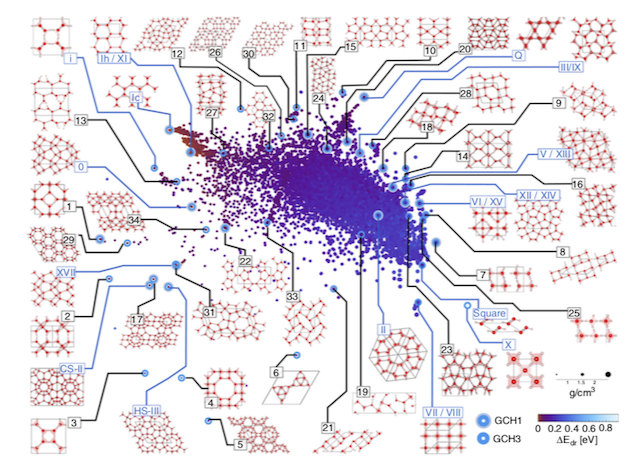
Submitted by Administrator on Wed, 27/06/2018 - 17:27
The phase diagram water ice is extremely complex, and has implications ranging from cloud formation to ice skating. Experimentally, 18 crystalline ice phases can be formed under various conditions, and many others have been proposed theoretically. A collaboration between the University of Cambridge and the École Polytechnique Fédérale de Lausanne has combined a high throughput computational search with modern materials informatics techniques to map the crystal structure space of ice, and identify 34 possible new phases.
The known stable phases of ice form tetrahedral (four-fold) hydrogen bonded networks of water (H2O) molecules. Databases of tetrahedral networks which have been generated for silica (SiO2) and contain millions of candidates, were used at a starting point to build thousands of possible ice structures. After removing those that were likely to have very high energy, full quantum mechanical density functional theory (DFT) structural optimisations are computed.
The optimised structures (almost 16,000) live in a very highly dimensioned configuration space. To help humans to comprehend this data, the configuration space was mapped onto two dimensions, using “sketch map” - an algorithm which places similar structures near to each other on the map.
Mapping uncharted territory in ice from zeolite networks to ice structures
Edgar A. Engel, Andrea Anelli, Michele Ceriotti, Chris J. Pickard & Richard J. Needs
Nature Communications, 9:2173, 2018
DOI: 10.1038/s41467-018-04618-6
Figure Caption: Nearly 16,000 DFT relaxed ice crystal structures are plotted using the “sketch map” algorithm, which places similar structures near to each other. A “generalised convex hull” identifies 34 structural diverse structures of ice that might be accessible under the appropriate thermodynamic conditions.

